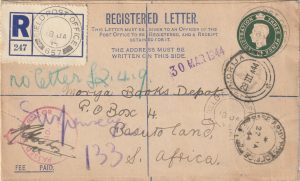Basutoland
Nestled in the highlands of Southern Africa, Basutoland—now known as the Kingdom of Lesotho—has a distinct postal history shaped by colonial rule, mountainous isolation, and a strong national identity. A land of rugged terrain and proud traditions, Basutoland was a British protectorate from 1868 until it gained full independence in 1966.
The region’s early mail was routed through the neighboring Cape Colony and later through the Orange Free State, with no stamps of its own until the 20th century. Basutoland’s first postage stamps were issued in 1933, featuring the portrait of King George V alongside imagery of Basotho life—herders, huts, and dramatic mountain scenes—making it one of the more visually distinctive British colonial issues. These early definitives emphasized the country’s geography and culture while cementing its place within the British Empire.
Stamps of Basutoland followed the standard colonial pattern, with successive issues depicting British monarchs—George VI and later Elizabeth II—alongside local scenes. However, what set Basutoland’s philately apart was its emphasis on the unique identity of the Basotho people, their traditional way of life, and their striking mountainous homeland. The country’s stamps often portrayed pony riders, woven blankets, and thatched huts set against the backdrop of the Maloti Mountains.
During the 1950s and early 1960s, Basutoland issued commemoratives celebrating royal visits, colonial milestones, and regional development. As the winds of decolonization swept across Africa, Basutoland prepared for independence, and its final stamp issues under that name marked the transition toward sovereignty.
On 4 October 1966, Basutoland became the independent Kingdom of Lesotho. The name “Basutoland” was retired, and the newly formed nation began issuing stamps under its new identity. Today, Basutoland’s philatelic output remains a fascinating and picturesque record of a nation moving from traditional monarchy through colonial oversight and into modern independence, capturing in miniature the resilience and pride of the Basotho people.


